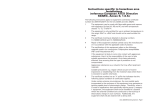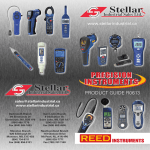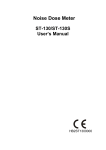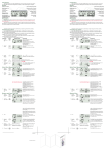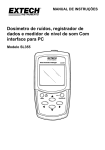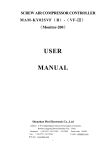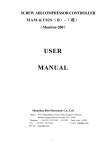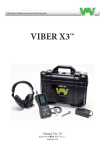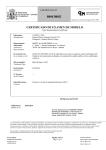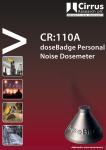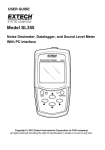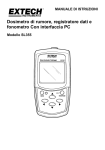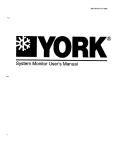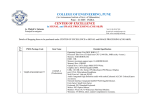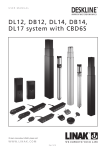Download CEL-360 User Manual - Campbell Associates
Transcript
Issue: 2 CEL-320/360 SERIES USERS GUIDE If you want to get on and use the instruments without any background information, skip Sections 3 - 5 and go straight to Section 6. 1. Display Battery Condition Data is Being Recorded Under range has Occurred Measurement is Paused Frequency Weighting Overload has Occurred CA REC dB% Measurement Identity or Date Current Mode, Pressing the MENU key will select each of these in turn 2. Indicates Active Option Keys Current Units SLM DATA SET UP OPTION Current Data or Time 01037e Keys DATA DATA MENU Display Switches instrument ON/OFF Changes operating mode Accesses stored data Select active options from the current menu Starts/Pauses/Restarts a measurement record Confirms actions of other keys Stops a measurement when followed by 01038 CEL-320/360 Getting Started - Page 1 3. Contents Section . . . . . . . . 1 2 3 4 4.1 4.2 4.3 5 5.1 5.2 6 6.1 6.2 6.3 4. Page Display . . . . . . . . . . . 1 Keys . . . . . . . . . . . . 1 Contents . . . . . . . . . . 2 Introduction to the Dosimeters . . . . . . . . 2 Sound Level Meter Models 3 CEL-320/320S Noise Dosimeters . . . . . . . 3 CEL-360/360S Logging Noise Dosimeters . . . . 4 Preparation for Use . . . . 5 Install Battery and Microphone . . . . . . . . 5 Perform Acoustic Calibration 5 Operation as a Dosimeter . 6 Select Dose Set Up for Use 6 Measure and Store Dose Data . . . . . . . . 7 Recall Dose Data . . . . . 8 Section . . . . . . . . Page 6.4 Review Stored Data . . . . 8 6.5 Print Standard Report . . . 9 7 Operation as a Sound Level Meter . . . . . . . . . . . 10 8 Selecting and Changing Options . . . . . . . . . . 11 8.1 Review Options . . . . . . 11 8.2 Set Time & Date . . . . . . 12 8.3 Change Timer and Run Duration (CEL-360 Series) . 12 9 Technical Information . . . 14 9.1 Specification . . . . . . . . 14 9.2 CE Compliance . . . . . . 16 9.3 Default Parameter Settings 16 9.4 Parameter . . . . . . . . . 17 10 Parts, Servicing & Warranty 18 10.1 Schedule of Parts . . . . . 18 10.2 Servicing & Warranty Arrangements . . 18 Introduction to the Dosimeters The CEL-320 and CEL-360 Noise Dosimeters have been developed from the successful CEL-420/460 range of instruments by adding features and improving the control procedures. They measure the frequency weighted noise exposures and peak sound levels simultaneously. The dosimeter microphone and lead on both models can be replaced by a sound level meter microphone to offer comprehensive sound level measurement. The CEL-320/360 series instruments have the following features. ¤ Seven built-in standard dose measurement setups: OSHA, MSHA, DOD, ACGIH, ISO85*, ISO90* and METER ¤ Up to 13 user specified dose measurement setups, ¤ A single sound level meter (SLM) setup, ¤ 50 dose (DATA) result stores, ¤ Storage of up to 10 profiles attached to each CEL-360 dose measurement, as specified by dB10 or dB12 software, ¤ Self configured storage. The instruments are built to withstand rough industrial conditions with cases formed from a polyester/polycarbonate material that gives them a Note*: ISO procedures using Criterion 85 dB and 90 dB. Page 2 - CEL-320/360 Getting Started high resistance to damage. Data integrity is further protected by a dose microphone lead which is designed to resist knocks and abrasions without affecting the signal passing from microphone to instrument. Both instruments can be operated and deliver dose and SLM results without the need for other equipment, beyond an acoustic calibrator. However, they become even more versatile when their measurement and setup data is transferred via a PC using the CEL-6702 dB10 or CEL-6704 dB12 Windows™ based software. These programs enable the instruments to be fully configured. Dose (DATA) setups can be added or removed from the instrument, while the individual measurement parameters can be added, deleted or changed in a setup. Some setup parameters, such as measurement range, can either be set to a particular value or left to the user to change via the instrument keypad. dB10 and dB12 have the facilities expected of fully featured 32 bit WindowsTM packages, enabling report production with cut and paste between applications and comprehensive word processing capabilities. In addition, dB12 has extensive on screen graphing facilities. 4.1 Sound Level Meter Models Both dosimeters can be converted to a miniature sound level meter by fitting a CEL-425 SLM Microphone Adaptor. The CEL-320 becomes a CEL-320S Sound Level Meter, while the CEL-360 becomes a CEL-360S Logging Sound Level Meter. The full model line up is shown in Table 1. Table 1: Models Available Standard Description Model CEL-320 Noise Dosimeter CEL-320S Sound Level Meter CEL-360 Logging Noise Dosimeter CEL-360S Logging Sound Level Meter For sound level meter operation refer to Section 8. 4.2 CEL-320/320S Noise Dosimeters The following features apply to the CEL-320 and CEL-320S. These instruments are ideal for quick on-site surveys and for monitoring personal noise exposure in accordance with European ISO or USA OSHA, MSHA, DOD and ACGIH standards. For dose measurement, they are passive instruments with settings that may be reviewed by key strokes, but which can be selected only by means of the dB10 or dB12 software. However, all sound level measurement parameters can be set from the keypad. There are three overlapping measurement ranges: 30 - 100, 50-120 & 70-140 dB, A & C RMS weightings, Linear & C Peak CEL-320/360 Getting Started - Page 3 weightings, Fast, Slow & Table 2: Setups and Configuration Files Impulse time weightings, and Parameter settings that do not modify preset measurement protocols can be changed by using energy exchange rates (Q) of the instrument keys. 3, 4, 5 & 6. In dose measureAll available parameter settings can be changed ment mode, they display % from a PC by means of dB10 or dB12 Software. dose, % dose projected for Parameter settings that modify preset measurement protocols must first be saved by dB10 or an 8 hour period, peak level dB12 under a new setup identity in an instrument and measurement duration. configuration file. For countries that are A configuration file contains a complete instrument set of setups, i.e. seven fixed dose subject to European Union setups, up to 13 user defined setups, one SLM regulations or the equivelent setup, and one timer setup common to all dose setups. ISO standards, these Parameter settings on an instrument can be instruments measure the changed ONLY by using dB10 or dB12 to replace daily sound exposure level the configuration file in the instrument by another configuration file loaded from the PC. (LAeq,8hr Pa2h according to IEC 1252, which is identical with the LEX,8h required by ISO 1999), while for USA OSHA/MSHA regulations they measure the Time Weighted Average level (TWA). When used as a sound level meter they display sound level, maximum sound level, minimum sound level, peak, time-averaged (LAeq or LAvg) sound levels and sound exposure level (SEL). 4.3 CEL-360/360S Logging Noise Dosimeters In addition to the features available to the CEL-320 Dosimeters, the following additional features apply to the CEL-360 and CEL-360S. These instruments are recommended for detailed measurements as they include extended processing and memory functions. There are automatic run timing facilities controlled by the built-in clock and time-history recording capabilities that allow up to 10 profiles to be saved with each dose (DATA) result set, in a separate profile store. Sampling times can be specified between 1 s and 1 hour by dB10 and dB12 software, while profile storage is in excess of 220 000 data points, where any single run can use up to 99 999 points. The instruments are able to measure and save up to five user specified Ln values (exceedance level percentiles). Run durations specified via instrument keys, by dB10 or dB12, and start and stop times preset via dB10 or dB12 can be switched on or off from the instrument keys. Other settings can be changed only by dB10 and dB12 Software. Once data saved by a CEL-360 instrument has been downloaded to a PC, the user can specify a period over which to re-calculate the projected % dose values. The software can also calculate six exceedance time percentiles with levels preset to values specified by measurement standards, plus one user specified time percentile. Page 4 - CEL-320/360 Getting Started 5. Preparation for Use 5.1 Install Battery & Microphone Connect a new 6LF22 or equivalent 9 V battery to the terminals in the battery compartment in the rear of the instrument. DO NOT disconnect the battery once runs have been stored as they will be lost ! With the instrument switched OFF, insert the lead connector of the CEL-6681 Dosimeter Microphone or the 960079 connector on the CEL-425 SLM Adaptor stalk into the socket on the top end of the case with the red dot facing the front of the dosimeter. Remove the connector ONLY by pulling on the knurled sleeve. CEL-425 SLM Adaptor Knurled Sleeve Red "Dot" DATA CEL-6681 Dosimeter Microphone MENU STOP SET ENTER 01042e 5.2 Perform Acoustic Calibration Operations are controlled by a sequence of key strokes. Calibrator Perform a field accuracy check each time the instrument is switched ON using a CEL-282 (Class 2) or CEL-284/2 (Class 1) Calibrator as follows. It is also recommended that another acoustic calibration be performed immediately O' Ring after completing a measurement run. The calibration levels from both before and after are stored with the run. When the second calibration occurs much later, provided the same microphone assembly is used, the second level is attached to any stored 1/4" Microphone run that has no second calibration. Shoulder Microphone Coupler 980057 CEL-320/360 Getting Started - Page 5 Fit the CEL-4725 Coupler supplied with the calibrator (CEL-282 or CEL-284/2) into the calibrator cavity, making sure it is firmly in contact with the shoulder in the cavity. (To aid removal, the coupler flange does not fit close against the calibrator housing). Fit the microphone into the coupler cavity, again ensuring that it makes contact with the shoulder in the coupler cavity. Then follow these instructions. Operation 1. Press Display Shows Switch the instrument ON Comments Start Up messages show: Instrument Type, Serial Number (when set), Print (when printer cable connected), DATA Firmware Version, finishing with the Last Used Operating Mode. 2. Change Operating Mode 3. To select OPTION, to enable Acoustic Calibration, it shows current SPL. MENU repeatedly OPTION Enable Level Change and are now enabled. The display shows current sound level. OPTION 4. Change Indicated Level or OPTION 5. Set Calibration Level Press or . Indicated level rises (falls) 0.05 dB for each key press. Adjust to correct level for CEL-320/360 microphones at standard temperature and pressure: 113.6 dB. The 113.6 dB calibration level is now set, and will be stored in the microphone assembly. OPTION 6. If the calibration is to be aborted OPTION The calibration level is NOT SAVED and the instrument continues to use the last saved calibration. 6. Operation as a Dosimeter 6.1 Select Dose Setup for Use Operation 1. Change Operating Mode Press Display Shows MENU repeatedly Page 6 - CEL-320/360 Getting Started A SET UP Comments To select SET UP. The first display always shows the currently loaded Setup, (for example OSHA dose measurement). Operation 2. Select another Set Up Press Display Shows Comments Select required Set Up from OSHA dose procedures, MSHA dose procedures, DOD dose procedures, ACGIH dose procedures, ISO85 dose procedures, ISO90 dose procedures, METER procedure, SLM (see Section 7). METER is a special procedure with neither threshold nor criterion, that allows the instrument to store data as a logging sound level meter. A several times SET UP 3. Load Selected Set Up for use Loaded messages show the Setup is now active (for example ISO procedure with 90 dB Criterion). A SET UP 6.2 Measure and Store Dose Data Operation 1. 2. Change Operating Mode Press Display Shows MENU repeatedly Comments This is dose measurement where the display can show dose data. DATA Start Run DATA When the run TIMER of a CEL-360 is ON (Section 8.3) with Beginning and End times set, the instrument waits showing the pause icon and the time remaining until the run starts. When the run TIMER of a CEL-360 is ON (Section 8.3) with SYNC ON, the instrument waits until the clock is synchronised with any selected profile time before the run starts. When the run Timer of a CEL-360 is OFF (section 8.3), or with a CEL-320, the instrument waits until the next whole clock second, then starts the run. 3. Then REC DATA 4. Inspect data from Current Run DATA REC DATA REC icon indicates that the instrument is now storing dose data in the first available data store. Shows where data from the current run is being saved (store 4) and on a CEL-360 indicates the number of completed profile periods. CEL-320/360 Getting Started - Page 7 Operation 5. Inspect further data from Current Run Press Display Shows Data from Current Run. several times DATA Pressing as for the CEL-420/460 series will also cycle the display. Comments The display cycles through data from current run (see Section 9.4). Some of these displays offer and options that show further parameters. The displays will be updated while the run is in progress. 6. If Required 7. If Required Pause the run. PLUS 8. If Required PLUS 9. The pause icon (II ) is shown. Press this key again to resume the run. To lock the keys and display The keys and display cannot be locked while the instrument to prevent unauthorised tampering. is paused. To unlock the keys and display to restore normal operation. Stop Run Stop ? This command must be confirmed. DATA 10. Confirm Stop The Run is now ended. DATA 6.3. All stored runs will be lost if the battery is disconnected ! Recall Dose Data Measured data stored while operating in the DATA mode can be DATA accessed via the key. Data from the run in progress can be inspected while the instrument is recording, as described in Steps 4 and 5 of Section 6.2. When the instrument is stopped, with no data being saved, stored data can be retrieved and displayed. 6.4 Review Stored Data Stored data is identified by date and measurement start time. Up to 50 runs can be stored simultaneously before the memory is overwritten by a “first-in/first-out” process. Operation 1. Enable Data Recall Press Display Shows Comments With the instrument stopped, DATA DATA DATA Page 8 - CEL-320/360 Getting Started pressing displays the Start Date & Time for the most recently stored run. Operation 2. Review Stored Runs Press Display Shows Comments Select Start Date & Time for required run (for example 4 June 09:10:00). repeat DATA 3. Review Stored Data Shows where data from the selected run is stored (store 3) and on a CEL-360 indicates the number of completed profile periods. DATA 4. Review Stored data The display cycles through data from the selected run (see Section 9.4). repeat DATA DATA Some of these displays offer Pressing as for the CEL-420/460 series will also cycle the display. 6.5 and options that show further parameters. If a printer is connected and switched on, the second data display shows PRINT READY (see Section 6.5). Print Standard Report With the dosimeter switched OFF, use both the C6671 Cable (supplied with all CEL-320/360 series instruments) and a CEL-6672 Cable to connect the instrument to a Centronics printer as shown. This C6672 Active allows the Printer Cable dosimeter to C6671 Communications recognise the Cable printer cable during its Start Up sequence. CEL-320/ Centronics Printer CEL-360 Only Series stored data can 01040e be printed, as the microphone and printer cannot be connected to the dosimeter at the same time because they both use the same “Red Dot” connector. Operation 1. Press Display Shows Switch instrument ON DATA 2. Enable Data Recall Comments Switch on both dosimeter and printer. DATA DATA Switch the printer On-Line. With the instrument stopped, display the Start Date & Time for the most recently stored run as described in Section 6.4. CEL-320/360 Getting Started - Page 9 Operation 3. Select Stored Run For Printing Press Display Shows Comments Select Start Date & Time for required run (for example 4 June 09:10:00). repeat DATA Continuing to press will eventually offer PRINT READY, followed by a PRINT ALL runs option that is enabled by pressing 4. Review Stored Data DATA 5. Activate Printing When the printer is connected and switched on, the second display shows PRINT READY. If the printer is off, the display will show PRINT OFF. DATA 6. Print Hard Copy The display shows busy plus print messages while printing the data set from the selected run in standardised format for measurement protocol used. DATA 7. . Shows where data from the selected run is stored (store 3) and on a CEL-360 indicates the number of completed profile periods. Operation as a Sound Level Meter In SLM mode, the instrument operates as a Type 2 sound level meter using settings made via the keypad, however, this mode cannot store data. For storage of sound level data, load the Meter setting from the setup list (Section 6.1), then operate as a dose meter (Section 6.2). Connect the CEL-425 SLM Adaptor (as described in Section 5.1), perform an acoustic calibration as described in Section 5.2, then proceed as follows. Operation 1. Press Display Shows Start from the final Start Up Display Comments The last used measurement mode will be selected. DATA 2. If required, change Mode Repeatedly 3. A MENU dB SLM Review SLM several Measurements times SLM mode can be selected only while a microphone is fitted. dB SLM Page 10 - CEL-320/360 Getting Started This is operation as a SLM with the current A-weighted Fast level (LAF) displayed. The display steps through all details and parameters (see Section 9.4), starting here with Linear Peak (LLpk) measurement. Operation Press Display Shows Comments When & icons are shown on the display, the relevant menu keys may be used to change the current measurement settings. 4. Final Measurement This completes the cycle back to first SLM display. A SLM 5. Switch OFF 8. Blank Screen No operations are possible. Selecting & Changing Options The OPTION mode accesses the part of the operating firmware that allows the following items to be checked or adjusted. Acoustic calibration (see Section 5.2), Adjustment of the calendar clock and time, Battery voltage, Communication status when the instrument is connected to a PC for use with dB10 or dB12 Soundtrack Software, Activating the Run Timer commands set by dB10 and dB12 (only on a CEL-360 series), Microphone temperature (oC). 8.1 Review Options Operation 1. Press Display Shows Comments Start from the Final Start Up Display DATA 2. Change Mode several times 3. Optional operations showing SPL for acoustic calibration, (see Section 5.2). MENU OPTION Next Option Repeatedly OPTION The display cycles through the rest of the options: Current Time, Current Date, Battery condition, Communication status, Timer status (CEL-360 series), Microphone Temperature, Erase: use this option with caution - IT DELETES ALL STORED DATA ! CEL-320/360 Getting Started - Page 11 8.2 Set Time & Date Operation 1. Press Display Shows Select Time Option Comments Follow on from Step 3 in Section 8.1. OPTION 2. Enable Time Change 3. Change the entry Cursors are enabled and the hours entry blinks to show it can be edited. OPTION or OPTION 4. Use and an entry. to highlight Use entry. to change the and The new time setting is stored. Save the Changes OPTION Repeat this process in the Date Option to set the date: PLEASE NOTE that the date format is dd mm yy. 8.3 Change Timer & Run Duration (CEL-360 series) Operation 1. Press Display Shows Select Timer Option OPTION 2. Switch Timer ON OPTION 3. Comments Follow on from Section 8.1. Review Timer settings OPTION Displays that are found only on CEL-360 series instruments are shown with a dashed outline - - - -. The Timer is now ON so that any start and stop times loaded via dB10 or dB12 will be used, UNLESS Synchronisation (SYNC) or Duration (DUR) settings are enabled as in steps 3 and 4. SYNC allows synchronisation to the next profile boundary, i.e to whatever interval has been set by the PC software. Press to enable or disable. The profile interval will also be shown. 4. Review Duration setting OPTION Page 12 - CEL-320/360 Getting Started DUR allows the user to select a run Duration time. When a run duration period is shown here or SYNC is ON, these take precedence over the Timer settings so that any preset start and stop times WILL NOT BE used. Operation Press Display Shows Comments Press to enable, use and to select the following durations: Off, 5, 10, 15, 30 minutes, 1, 2, 4, 8, 10, 12, 24 hours, then confirm with 5. Review Repeat setting . Rept allows the user to select up to 49 repeats of the timer settings. OPTION Press to enable, use and to select the number of repeats, then confirm with 6. Review Start/ End Times OPTION . This is the First Beginning (start) time set by dB10 or dB12: dd.hh:mm. The day setting is the day of the month. When day - - is indicated, measurement will start on the current day. Press in either the Beg or End screen to enable/ disable each timer pair. When a pair is disabled, its settings will be shown as - - - - -. 7. Review Start/ End Times 8. Review further Start/ EndTimes This is the First End (stop) time set by dB10 (or dB12): dd.hh:mm. OPTION Start/End times. Repeat The display steps through 16 sets of Start/End times. CEL-320/360 Getting Started - Page 13 9. Technical Information 9.1 Specification Dosimeter/Sound Exposure Meter Standards: IEC 61252: BS EN 61252, ANSI S1.25 - 1992 for dosimeters and sound exposure meters. The sound level at which this personal sound exposure meter conforms tometer clause of thisinstandard is 85using dB. The personal exposure was15tested Dose mode 85 dB due tosound the duration of testing. The instrument has no additional connector points during normal mode of operation. N.B. When downloading data using cable no C6671, the meter conforms to the requirements for EMC emissions and immunity as specified and 61000in- IEC 6 - 4:61000 1997.- 61:1997, 61000 - 6 - 2:1999, 61000 - 6 - 3:1996, The configuration for the normal mode of operation is measurement set-up ISO 85 or ISO 90. There is no degradation in performance or loss of functionality following the application of electrostatic discharges. The approved configuration for the reference orientation is with the instrument secured to a nonmetallic backing material with the microphone cable secured horizontal figure of eight starting approximately 10 cmin aabove the instrument. Theconfiguration figure of eight is constructed of four even folds of the microphone cable 14 cm across. The figure of eight is then secured at each end and in the centre. The microphone housing is then secured approximately 10 cm above the centre of the figuredirection of eight configuration. front ofoftheradio-frequency instrument is facing the principal of an emitter orThereceiver electromagnetic fields. All settings and orientations of the instrument have similar radiofrequency emissions. These radio-frequency emissions are within the specified limits of this standard. All modes of operation and connecting device configurations have similar immunity to power and radio frequency fields. ANSI S1.4 - 1983 Type S(1) for sound level meters, IEC 60651 - 1979 : Type 2I for impulse sound level meters, IEC 60804 - 2000 : Type 2 for integrating sound level meters. ANSI S1.43 - 1997 for integrating sound level meters. The sound level at which the sound level meter conforms to specifications of clause 12 of IEC 60651 is 74 dB. The instrument has no additional connector points during normal mode of operation. The configuration for thevianormal mode ofpreamplifier, operation isFrequency specified with the microphone connected the standard weighting: A-weighted, Sound Pressure level, Time Constant: Fast, Measurement Range: 70 - 140 dB. Electromagnetic and electrostatic compatibility: Sound Level Meter/Integrating Sound Level Meter Standards: Page 14 - CEL-320/360 Getting Started There is no degradation in performance or loss of functionality following the application of electrostatic discharges. The approved configuration for reference orientation as viewed by the operator is with the instrument in a horizontal position facing the noise source where the receiver of the electromagnetic field replaces the noise source. All settingsemissions. and orientations the instrumentemissions have similar frequency These ofradio-frequency areradiowithin the specified limits of this standard. All modes of operation and connecting device configurations have similar immunity to power and radio frequency fields. >53 dB Pulse Range: Measurement Ranges: Display Range (dB) Primary RMS range at 1 kHz Peak 30 - 100 41 - 86 63 - 103 50 - 120 55 - 106 83 - 123 70 - 140 75 - 125 Defined from 10 dB above noise floor to a crest factor limit of 5 103 - 143 Weightings: A, C and linear 20Hz - 20kHz, Fast, Slow, Impulse, Peak, 3, 4, 5, 6 dB exchange rates. Date and time can be set from the keypad. Date and time can be set to PC time via dB10 and dB12. (CEL-360 Series only) Use with pre-programmed delayed start and stop times, or with fixed measurement durations can be selected from the keypad. (Start and Stop times must be programmed via dB10 and dB12.) (CEL-360 Series only) Delay intervals can be set only via dB10 and dB12. Settings can be specified for up to 16 sets of start and stop times, up to 30 days ahead. The clock indicates the time remaining before the next run starts. (CEL-360 Series only) Measurement elapsed times (run durations) keypad. The following options are available: can be selected from the Disabled, 5, 10, 15, 30 minutes, 1, 2, 4, 8, 10, 12, 24 hours. 69.0 dB RMS (i.e. 1 dB below the bottom of the selected range). Frequency: Time: Amplitude: Clock: Dose Measurement Timer: Dose Measurement Start/Stop Delay Timer: Dose Measurement Elapsed Time Timer: Under Range Indication: CEL-320/360 Getting Started - Page 15 Overload Indication: 140.1 dB RMS (i.e. 0.1 dB above the top of the selected range). 143.0 dB Peak Linear (i.e. 3.0 dB above the top of the selected range). Error <±1 dB at frequencies >10 Hz. 1 second. Temperature ± 0.5 dB: -10oC to +50oC, Atmospheric - 108(non-condensing), kPa, Humidity ± 0.5Pressure: dB: 30%65- 90% Magnetic Fields: Negligible, Vibration: Negligible. 9 V, 6LF22 or equivalent for normal use, lifetime at least 40 Hours. 9 V, Duracel MN1604, lifetime approx 24 Hours. 120 x 65 x 30 mm, 260 g. 4.8 x 2.6 x 1.2 inches, 9 oz. Maximum Peak Value: Non-Linear Distortion: Stabilisation Time: Operating Environment: Battery: Dimensions and Weight: 9.2 CE Compliance All models in the CEL-320/360 Series comply with the EMC Directive 89/336/EEC of the European Union. They have been tested according to the standard delivery schedule and comply with the following standards. EN 50081-1 : 1992, EN 50081-2 : 1993: Generic emission standards for residential, commercial, light industry and industrial environments. EN 50082-1 : 1992, EN 50082-2 : 1995: Generic immunity standards (for both RF fields and electrostatic discharge) for residential, commercial, light industry and industrial environments. 9.3 Default Parameter Settings Setup OSHA MSHA DOD ACGIH IS085 IS090 Measurement 70 - 140 70 - 140 70 - 140 70 - 140 70 - 140 70 - 140 METER SLM A A A A A A Time weighting S S S S F F F S Amplitude 5 5 4 3 3 3 3 3 L L L L C C C L 80 80 80 80 70 70 0 x 50 - 120 70 - 140 range (dB) Frequency A A weighting weighting Peak frequency weighting Threshold 1 (dB) Page 16 - CEL-320/360 Getting Started Setup Threshold 2 OSHA MSHA DOD ACGIH IS085 IS090 METER SLM 90 90 x x x x x x (dB) Criterion (dB) 90 90 85 85 85 90 0 x LN%A L10 L10 L10 L10 L10 L10 L10 x LN%B L50 L50 L50 L50 L50 L50 L50 x LN%C L90 L90 L90 L90 L90 L90 L90 x LN%D L95 L95 L95 L95 L95 L95 L95 x LN%E L99 L99 L99 L99 L99 L99 L99 x Profile interval 1 min 1 min 1 min 1 min 1 min 1 min 1 min x Profile 1 Lavg Lavg Lmn Leq Leq Leq x Lavg Profile 2 Leq Leq Leq Leq Lmx Lmx Lmx x Profile 3 Lmx Lmx Lmx Lmx Lmn Lmn Lmn x Profile 4 Lpk Lpk Lpk Lpk Lpk Lpk Lpk x Synchronise Run start in Yes CEL-360 model Yes Yes Yes Yes Yes Yes No No No No No No No Yes Yes Reference 29 CFR 30 CFR 62.0 DoD DHHS Pub Noise at Noise at CEL CEL document 1910.95 UMHRPEL Instruction 98-126 Work Work suggestion suggestion Regulations Regulations 1989 1989 Allow user to change set up 6055.12 9.4 Parameter Identities The following time weightings and other identities may be shown. A A-weighting C C-weighting L Linear S Slow, F Fast, I Impulse, Q Energy conversion factor PK Peak, MX Maximum, MN Minimum, EQ Equivalent continuous level, AV Average level, EP,v* Noise dose normalised to a user selected (variable) period of hours and minutes, When the period is set to 8 hours, this will be shown a EP,d. TWAv* Time Weighted Average is the normalised time averaged sound pressure level with the selected frequency and time weighting that represents Note*: This parameter can be enabled only via the dB10 or dB12 PC software. CEL-320/360 Getting Started - Page 17 N AE the total Avg of a person’s workplace noise exposure averaged over a user selected (variable) period of hours and minutes. This unit is specified in the USA: OSHA standard 1910-95 published in 1983. When the period is set to 8 hours, the unit will be shown as TWA. Percentile sound level, Sound exposure level. 10. Parts, Servicing & Warranty 10.1 Schedule of Parts A complete Noise Dosimeter or Sound Level Meter consists of: CEL-320/360 Noise Dosimeter as applicable, Either: CEL-6681 Type 2, ¼" Electret Microphone Assembly for use as a dosimeter, complete with clip and 0.8 m captive cable, Or: CEL-425 Sound Level Meter Adaptor with Type 2, ¼" Electret Microphone Assembly for use as a sound level meter, CEL-6702 dB10 Control and Download software (supplied with CEL-320), CEL-6704 dB12 Control, Download and Graphing software (supplied with CEL-360), C6671 Communication cable to PC, 016014 Alkaline-Manganese Battery (IEC 9LF22), 060333 Users Guide, A5 multilingual instructions, 060335 Field Guide, pocket guide. 10.2 Servicing & Warranty Arrangements To ensure its conformity with the specification, this instrument is thoroughly inspected and it’s accuracy verified prior to dispatch. All technical information is filed under the instrument serial number, which should, therefore, be quoted in any correspondence. The manufacturers undertake to rectify any defect in the instrument that is directly attributable to faulty design or assembly, and which becomes apparent during the warranty period. In order to take advantage of this warranty, the instrument must be returned, carriage paid, to the manufacturer’s factory or accredited agent, where necessary repairs will be carried out. Page 18 - CEL-320/360 Getting Started The warranty period runs for 12 months from the date of receipt of goods, with exceptions on certain specialised components supplied by other manufacturers which may be warranted for shorter or longer periods by their actual manufacturers. In all such cases, the benefit of these undertakings will be passed on to the user. CASELLA CEL’s liability is limited to items of their own manufacture, and they do not accept liability for any loss resulting from the operation or interpretation of the results from this equipment. To obtain repair under warranty, the instrument should be packed and returned in it’s original packing or an equivalent either to CASELLA CEL’s local agent, or in the case of U.K. domestic sales, to the CASELLA CEL Service Department at Bedford. Please include the following information: Instrument Type(s), Serial Number(s) and Firmware Version Number(s), Customer name and address, Contact name and phone number, Details of any PC and Software involved, including Version Number(s), Reason for returning the equipment with a detailed description of the fault, List of any error messages that may have been displayed. The necessary adjustments or repairs will be carried out, and the instrument returned as soon as possible. A comprehensive Instrument Calibration Maintenance Agreement (ICMA) scheme is available to extend the initial warranty period of this instrument. At the end of the first warranty period, it is recommended that the equipment be returned to the Service and Verification Department at Bedford, where it will be inspected and entered into the ICMA scheme as required. The warranty will then be extended for the period stated on the individual schedule. Please contact your local CASELLA CEL agent for full details of this service. After the warranty has expired (except on approved accounts) service work is undertaken against quotations, and all packing and transit costs are charged extra. CEL-320/360 Getting Started - Page 19 Page 20 - CEL-320/360 Getting Started




















